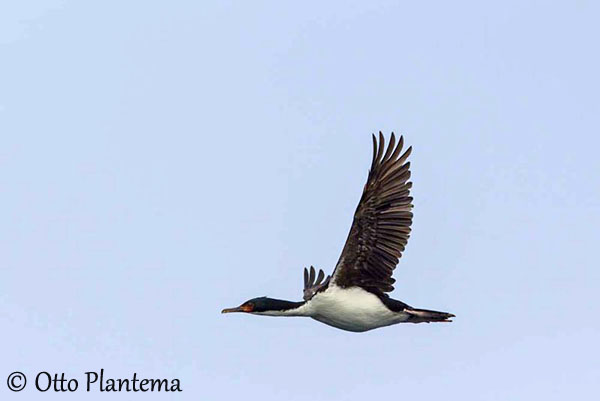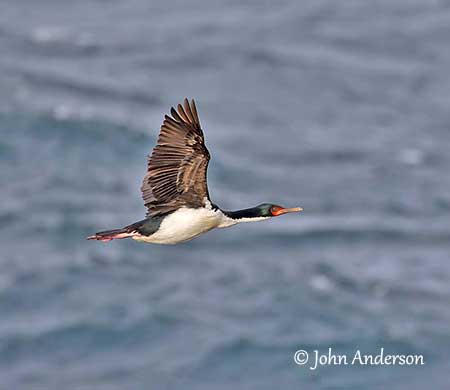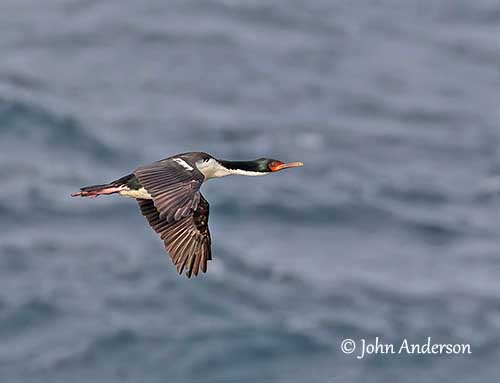
Fr: Cormoran de Bounty
Ang: Bounty Island Shag - Bounty Shag
All: Bountyscharbe
Esp: Cormorán de las Bounty
Ita: Cormorano delle Bounty
Nd: Bounty-aalscholver
Sd: Bountyskarv
Photographers:
John Anderson
John Anderson Photo Galleries
Otto Plantema
Trips around the world
Text by Nicole Bouglouan
Sources:
HANDBOOK OF THE BIRDS OF THE WORLD vol 1 by Josep del Hoyo-Andrew Elliot-Jordi Sargatal - Lynx Edicions - ISBN: 8487334105
BirdLife International (BirdLife International)
New Zealand bird status between 2008 and 2012
Te Ara – The Encyclopedia of New Zealand
Page family Phalacrocoracidae
Summary cards
Bounty Island Shag
Leucocarbo ranfurlyi
Suliformes Order – Phalacrocoracidae Family
INTRODUCTION:
The Bounty Island Shag is endemic to the remote subantarctic Bounty Islands, about 670 kilometres SE to New Zealand. These islands are a nature reserve with limited access, and the formerly introduced predators have been eradicated. The population size is small but stable, in spite of living in reduced range.
DESCRIPTION OF THE BIRD:
Biometrics:
Length: 71 cm
Weight: 2300-2900 g
The adult has black head and upperparts, with blue sheen on most feathers. On the upperwing, the wing-coverts are dark brownish-black with bronzy sheen. Numerous individuals show variable white wing patches over lesser and some median wing-coverts. Some males may have white markings on the back too.
The underparts are white, including chin, throat and foreneck. The outer side of the thighs is black. The underwing is blackish with variable white bar at base of the leading edge.
The head is black with greenish gloss. In breeding plumage, the facial skin is red to dark red, whereas gape and gular pouch are brighter orange-red. There is a single, rather long, black crest on the forecrown. The caruncles are absent.
The slender bill is brown or pink with dark ridge and paler hooked tip. The eyes are dark greenish-grey to light brown. Legs and webbed feet are pink with variable grey markings on tarsi and toes.

REPRODUCTION OF THIS SPECIES:
The breeding season starts in October.
The female builds the nest with materials brought by the male. The nest is a flattened bowl made with brown algae (Marginarilla), feathers, stones and mud.
The Bounty Island Shag breeds in colonies on narrow ridges on sea-cliffs, on ledges or in alcoves. The nests are about a metre apart.
Some displays still occur at nest until all the eggs are laid.
The female lays 2-3 eggs, and both sexes share the incubation. The changeover is accompanied by greeting ceremonies between mates while the male produces soft sounds. It collects material for the nest through the incubation period, often regurgitating pellets and pebbles.
The hatching may occur in late November and December. No more information.
PROTECTION / THREATS / STATUS:
The Bounty Island Shag has very restricted breeding areas due to competition for breeding space with marine mammals, Sulidae and Spheniscidae.
The natural predators such as the Brown Skua and the Kelp Gull sometimes take eggs and chicks.
However, the major threat for this species is the weather. Severe storms may involve chick losses due to the exposed nesting areas on cliffs. The adults can be killed by storms while foraging too.
But in spite of these threats, the small population appears stable. There are at least 620 individuals with 410 mature birds.
The species is currently classified as Vulnerable, and was moved to Nationally Endangered in 2013, with predicted decline 10-50 %.
The non-breeding adult is duller, with reduced or absent crest.
Both sexes are similar with the male slightly larger than the female.
The juvenile has brown upperparts and pale facial skin.
RANGE:
The Bounty Island Shag is found on Bounty islands, SE to New Zealand. The species also occurs in the adjacent surrounding inshore waters.
HABITAT:
The Bounty Island Shag forages and feeds at sea and near the coasts. It breeds on sea-cliffs, on ledges or in alcoves, and along narrow rocky ridges.
CALLS AND SONGS:
The Bounty Island Shag male produces soft purring “corr-corr” at rest, and utters ticking calls during the courtship displays, including some “he-he-he” while performing gaping-display. While mating, it makes soft “borr-borr-borr”. The female is usually more silent.

BEHAVIOUR IN THE WILD:
The Bounty Island Shag feeds on small fish and marine invertebrates such as cephalopods, isopods, crabs and sea urchins. They can form large feeding flocks of up to 300 individuals. Like other cormorants, it dives from the surface and pursues the prey underwater. This species forages on the seabed.
Like the other “pink-footed” shags, it does not dry its wings by spreading them.
During the breeding season, the male performs typical displays such as “gargling” while it stands erect and swings the head backwards until touching the rump. It also performs “bill-gaping” to display the bright coloured gape, with raised tail and dropped wings.
During this period, the male occupies and defends some suitable nest-sites.
The Bounty Island Shag is sedentary, but it can be vagrant to Antipodes Islands, S to Bounty Islands.
The flight is powerful with regular wingbeats interspersed with some glides.
